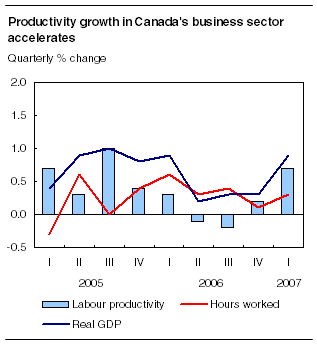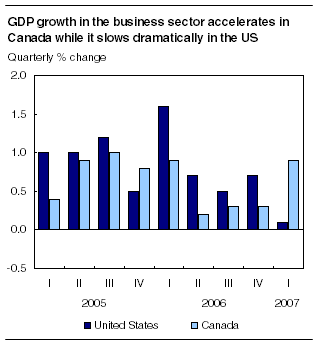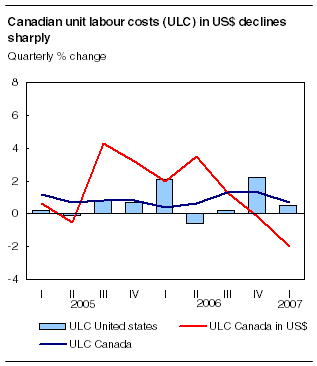Common menu bar links
Labour productivity, hourly compensation and unit labour cost
Archived Content
Information identified as archived is provided for reference, research or recordkeeping purposes. It is not subject to the Government of Canada Web Standards and has not been altered or updated since it was archived. Please "contact us" to request a format other than those available.

The year 2007 opened on a solid note for productivity in the Canadian business sector. Between January and March, quarterly labour productivity growth accelerated to 0.7%, more than three times the pace in the previous quarter (+0.2%).
Canadian businesses managed to triple their production rate from the previous quarter, while hours worked increased at a more moderate pace. This surge in productivity in the first quarter of 2007 was the largest gain since the 1.0% recorded in the third quarter of 2005.

Both the services-producing and the goods-producing industries made positive contributions to the overall productivity performance in the first quarter. Gains were observed in manufacturing, construction, agriculture, forestry, fishing and hunting as well as in wholesale and retail trade, and finance and insurance services.
Note to readersThis release contains a brief analysis of detailed data on labour productivity growth and other related variables. A more thorough analysis, including additional charts and tables, is available in the Canadian Economic Accounts Quarterly Review. The term "productivity" herein refers to labour productivity. Calculations of the productivity growth rate and its related variables are based on index numbers rounded to one decimal place. For more information about the productivity program, see the new National Economic Accounts module accessible from the home page of our website. You can also order a copy of a technical note on the quarterly estimates of productivity by contacting Client Services (productivity.measures@statcan.gc.ca). Revisions The first quarter 2007 labour productivity estimates released today include revisions to aggregate labour productivity and underlying series (gross domestic product, hours worked, unit labour costs, etc.) from 2003 to 2006. These updates are consistent with the four-year annual revision to the National Income and Expenditure Accounts released May 31, 2007. However, the national accounts' estimates of gross domestic product (GDP) by industry will not be revised until the end of September 2007 (the usual revision release date for GDP by industry), and, therefore, will be not incorporated in the productivity estimates until the release of the third quarter data in December 2007. As a result, revised estimates of labour productivity by industry (including revisions to industry estimates of GDP, hours worked, labour compensation and unit labour costs) will only be available with the third quarter release. |
Labour productivity, as measured by real gross domestic product (GDP) per hour worked, is a key factor in higher economic growth and long-term improvement in the standard of living.
In the United States, quarterly productivity growth in the American business sector remained lacklustre. With a slowdown in economic activity, American productivity increased only 0.1% between January and March, a slower growth than in the fourth quarter of 2006.
Best performance in productivity in Canada in more than a year
Productivity increased at a faster pace in Canadian businesses than in American businesses in the first three months of 2007, as a result of a much stronger output growth in Canada.
The gap in productivity growth between the two countries stems primarily from the difference in business sector real GDP growth. For the first time in over a year, the United States experienced a significantly weaker GDP growth than Canada in the first quarter.
In Canada, real GDP in the business sector grew 0.9% in the first quarter of 2007, three times what it was in the previous quarter (+0.3%). It was the highest quarterly growth in a year.
Consumer spending on goods and services, which edged up to 1.0% from 0.9% the previous quarter, continued to drive the economy. The accumulation of business inventories, due to increased output, also made a positive contribution to Canada's quarterly GDP growth.

American business sector GDP rose only 0.1% in the first quarter, substantially lower than the 0.7% increase observed in the last three months of 2006. In fact, it was the smallest advance since the fourth quarter of 2002 (+0.1%), just before the Iraq war.
Hours worked devoted to production in Canadian companies grew 0.3% in the first quarter, up slightly from the increase of 0.1% in the previous quarter. Most of the increase in hours worked between January and March was in part-time work.
There was a sharp contrast between the United States and Canada in hours worked over the last two quarters. Specifically, hours worked in American businesses edged down in the first quarter, after advancing 0.3% in the fourth quarter of 2006. Hours worked has been slowing gradually since the third quarter of 2006.
Unit labour costs slows in both countries
Unit labour costs slowed significantly in both Canada and the United States in the first quarter of 2007. Nevertheless, when measured in their respective national currencies, unit labour costs rose slightly faster in Canada than in the US.
Unit labour costs, as measured by the cost of wages and benefits of workers per unit of economic output, are an indicator of inflationary pressures on wages.
Labour costs per unit of output in Canadian businesses climbed 0.7% in the first quarter, compared with 1.3% in the previous quarter. This substantial improvement was attributable to higher productivity as well as to slower growth in hourly compensation, which decelerated from 1.7% in the fourth quarter of 2006 to 1.4% in the first quarter. For American businesses, unit labour costs were up only 0.5% in the first quarter, a sharp deceleration from the 2.2% increase recorded in the previous three months.

However, Canadian businesses had a more favourable competitive position when the unit cost of labour was adjusted for the exchange rate. In the first quarter, the Canadian dollar depreciated by 2.8% against the US dollar, which resulted in a 2.0% decline in Canadian unit labour costs, expressed in American dollars. This was the second consecutive quarterly decline in this indicator.
Recent revisions to Canadian productivity estimates have little impact on the Canada/US gap
Overall, the 2003 to 2006 revisions lowered the annual rate of growth in Canadian labour productivity in 2004 and 2006, and increased it in 2003 and 2005. The magnitude of these revisions ranged from a decline of 0.3% to an increase of 0.4%. For example, for 2006, productivity growth in Canadian businesses was revised downward from 1.2% to 1.0%. The 2005 productivity growth in Canada was revised up from 2.1% to 2.5%.
| Comparison of annual labour productivity growth in the business sector before and after revision | |||||
|---|---|---|---|---|---|
| Canada | United States1 | ||||
| Before revision | After revision | ||||
| annual % change | |||||
| 1981 to 2006 | 1.5 | 1.5 | 2.2 | ||
| 1981 to 2000 | 1.6 | 1.6 | 1.9 | ||
| 2000 to 2006 | 1.0 | 1.0 | 2.9 | ||
| 2003 | 0.0 | 0.3 | 3.8 | ||
| 2004 | 0.3 | 0.0 | 3.1 | ||
| 2005 | 2.1 | 2.5 | 2.1 | ||
| 2006 | 1.2 | 1.0 | 1.7 | ||
| |||||
These revisions tend to cancel each other out. As a result, they had no impact on the average gap in productivity between Canada and the United States during the post-2000 period. With these revisions, however, productivity growth is now higher in Canada in 2005 than in the US.
Available on CANSIM: tables 383-0008 and 383-0012.
Definitions, data sources and methods: survey number 5042.
A more comprehensive analysis, including additional charts and tables, can be found in the first quarter 2007 issue of Canadian Economic Accounts Quarterly Review (13-010-XWE, free), which is now available from the Publications module of our website.
Second quarter data for labour productivity, hourly compensation and unit labour cost will be released on September 14.
To order data, or for general information, contact Client Services (productivity.measures@statcan.gc.ca). For more information, or to enquire about the concepts, methods or data quality of this release, contact Jean-Pierre Maynard (613-951-3654; fax: 613-951-3618; maynard@statcan.gc.ca), Income and Expenditure Accounts Division.


 Table(s).
Table(s).